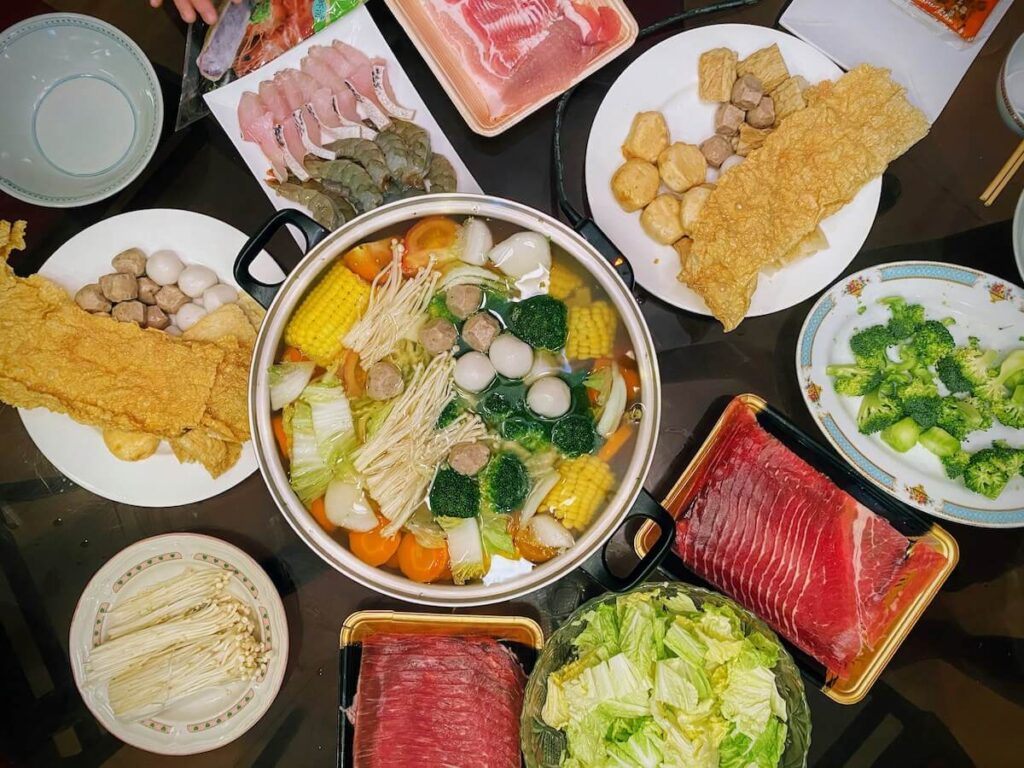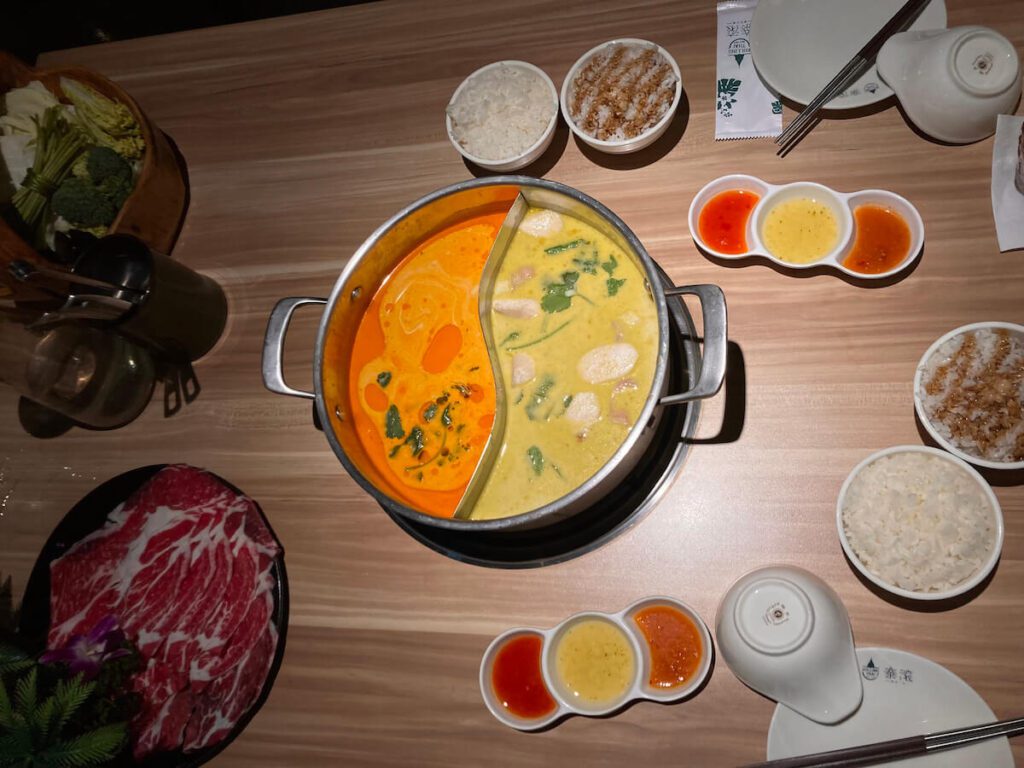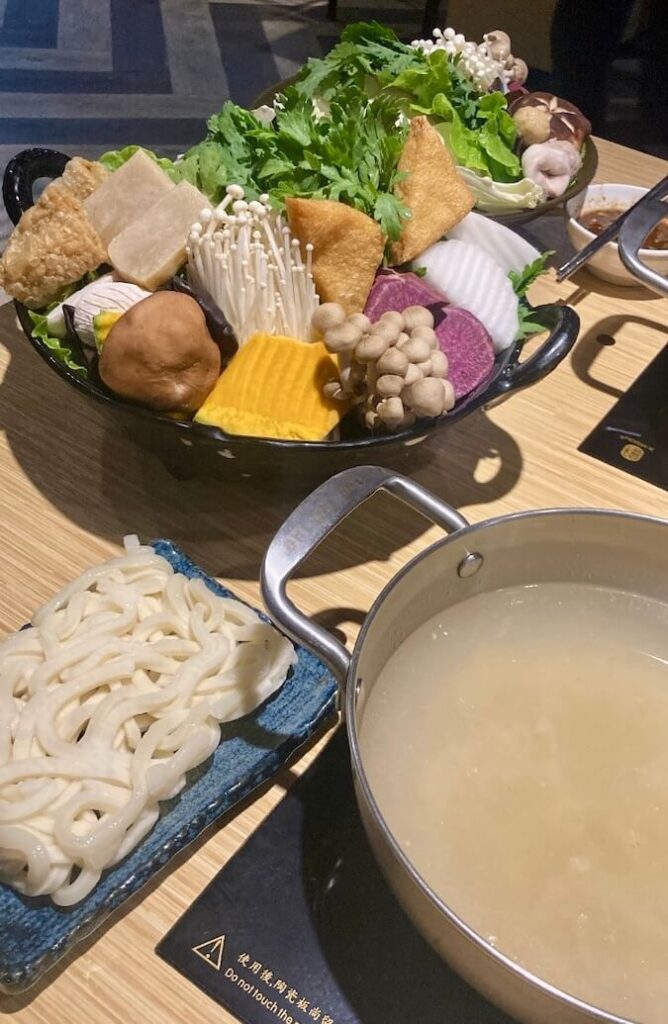Master the Art of Hotpot: The Essential Guide on How to Eat Hotpot (2024)
We’ve got multiple broths, uncooked meats and veggies, a plethora of various ingredients to add to your dipping sauce, where to begin? Don’t worry, I’ve created the perfect guide on how to eat hotpot so you’ll feel like a pro by the next time you eat it!
This post may contain affiliate links which means I’ll receive a commission, at no extra cost to you, if you purchase through my link. Thank you for your support 🫶

My first exposure to hotpot was a wild one (for me at least). Soon after sitting down with my friends, confused on all the meats and veggies listed on the menu, we were getting up – getting up? Where are we going?
We were walking towards a counter when I saw it – garlic, chilis, peanut powder, soy sauce, vinegar, what’s that brown stuff? I was deeply confused and had no idea where to begin.
It was intimating to say the least.
So began my journey of learning how to eat hotpot! About 3 months later, I moved to Taiwan where hotpot is a staple in their diet. I hoped my new-found Taiwanese friends would show me the way, but all they said was “Just do it however you’d like.”
Do it however I’d like? What is it though? Do I cook the meat first? Or the vegetables first? Can I use my hands to place the food in the pot or should I use chopsticks? And where to begin with making the sauce?
Maybe I thought a little too hard about it, but I really wanted to learn how to eat hotpot the right way.
After questioning all of my Taiwanese friends, dates, and students (my students were adults), along with having my own personal experiences with trial and error over the course of four years, I can confidently say: I can teach others how to properly eat hotpot.
And let me tell ya, you are in for a treat. What once was a boiling bowl of confusion has now turned into one of my favorite meals. It’s a beautiful time to cook yummy food with friends and/or family, talk, laugh, and enjoy the process of creating your meal.
Here’s my guide on everything you need to know to eat hotpot perfectly:
How to Eat Hotpot | The Basics

The Table
When you first sit down there will be two options for the hotpot bowl, it’s either a personal hotpot or a communal one.
Personal ones will usually come with just one broth, whereas the communal one will have the option of one, two, or even four different types of broths.
Each restaurant (and country) is different, but those are the typical options. If you’re splitting the pot into multiple broths, most people will choose one spicy (mala) and one mild one.
The broths options typically include various meats (like beef, pork, or chicken), a spicy (mala) broth, a vegetarian option (usually mushroom or tomato), and maybe a signature one.
The broth is what you’ll be cooking everything in, so choose whichever option sounds best to you! I usually pick a chicken, beef, or vegetarian option.
One thing to note: Some restaurants don’t have an option for broth, it’s just whatever is already set at the table.
How to Boil the Broth
Speaking of the table, how to turn on the stove in the table depends on if it’s a communal or personal hotpot.
In a communal table, the knob to turn on the stove is typically at the head of the table in relation to where the front door is (not always, but most of the time). Often the waiter will turn it on for you in Asia so you don’t have to go searching for it, but sometimes they’re busy and you’re left to fend for yourself.
If it’s a personal hotpot, then it’s typically right in front of the seat, just below the table surface. You may need to push your chair back slightly to see it.
They all look the same and are pretty straight forward with which direction to turn the knob or what buttons to press to get it boiling.
What to Order | The Menu

Proteins
After choosing your broth, you get to pick and choose your protein.
If it’s a buffet, all-you-can-eat style, you just walk up and pick and choose what looks good to you. If it’s a regular restaurant, you will order off the menu. It’s pretty standard to choose a variety of meats and seafood while eating hotpot in Asia.
Most options include thinly sliced beef, lamb, and pork; some restaurants will do thinly sliced chicken, but it’s more common to have chopped chicken rather than thinly sliced. Because of this, most people will choose beef, lamb, or pork instead since it cooks faster, it’s easier to eat, and adds lots of flavor to the broth.
For seafood, it’s typical to see various fish, oysters, mussels, shrimp, squid, crab, and sometimes even lobster! If you’re in Asia, the shrimp will come with the full body and head. Careful when peeling the shrimp, the soup can hang out in the cravesses and burn your fingers as your peeling it.
Lastly, you’ve got the dumplings, meatballs, and fish balls which add a nice flavor to the broth and texture when eating.
With my experience in Taiwan, picking a variety of protein is the status quo: 1-2 kinds of meat, 1-2 kinds of seafood, and usually just 1 of the dumplings/meatballs/fishballs is what you’ll order when you’re with a friend, or more, if you’re with a group of people.
When eating out alone (which is very common) people usually order whatever they like, typically one kind of meat and/or one kind of seafood.
Veggies
On the menu, you’ll usually get the option of a basket of a variety of veggies rather than individually ordering them, and any popular or unpopular veggies you can order separately.
The baskets usually consist of 1-2 kinds of leafy veggies, such as cabbage and bok choy; 1-2 kinds of mushrooms, such as enoki, shimeji, black wood ear, and oyster mushrooms; 1-2 kinds of root veggies such as taro, sweet potato, and/or pumpkin; a thick slick of a tomato and a corn on the cob, a cube or two of tofu, and a thin slice of tofu skin (if you’re lucky).
Clearly, they don’t mess around with their veggies!
Carbs
I’m a noodles over rice gal any day of the week. Unfortunately, I’m also sensitive to gluten, so I learned early on that I needed to order rice instead (QQ).
However, the options for noodles are plentiful! You can usually get udon (my personal favorite), vermicelli, bean vermicelli, rice noodles, and dry egg noodles.
Rice would typically just be rice, but, in Taiwan, some restaurants would offer the classic Taiwanese dish of Lu Rou Fan (braised pork rice).
Pick whatever your lil heart desires.
The SAUCE
This honestly should have an article of its own. However, I will do my best to simplify it down for you so you feel ready to tackle that counter upon arrival. Let’s get into it.
Alright, so after ordering you are going to get up and go to a counter space where there will be anywhere from 6 – 10+ options to create the perfect dipping sauce for your meats and veggies.
You will usually get these options:
- Soy sauce (+varieties)
- Black vinegar
- White vinegar
- Rice vinegar
- Sesame Oil
- Chili paste or freshly chopped chilis
- Shacha (must-try!)
- minced or chopped garlic
- chopped green onions
- cilantro
To name the basics. Often there are more options and it’s a fun experiment to figure out exactly what you like.
If you’re staring at that list, feeling scared of even remotely trying to figure that out – here is my go to sauce:
- 2 scoops of Shacha
- 2 scoops of soy sauce
- 1 scoop of white vinegar
- allll the garlic, green onions, and cilantro
- topped off with a hint of freshly chopped chilis
If it’s too watery, I add more Shacha. If it’s too thick, I add more soy sauce and/or vinegar.
How to Cook Your Ingredients | The Finale

Method 1 | The Taiwanese Way
So, after living in Taiwan for four years, there was an overall consensus among my Taiwanese friends and students.
First, you cook the veggies in the broth. Once those are getting close to being done, they will add in one slice of their meat to combine the ingredients, dip them in the sauce, and eat with their rice.
They like to eat their veggies first and then combine it with the meat because they feel the broth gets too oily when you cook all of your meat with the veggies.
Once they’ve cooked everything, or are full, they will sip their broth for a yummy, nutrient-filled soup.
Method 2 | My Way
I followed the Taiwanese way for most of my time in Taiwan. But, one day, I realized I enjoy eating it all at once. I like my meat cooking with my veggies, I want a bite filled with veggies, meat, and rice – every time! So, I did just that and haven’t looked back since.
So, first I do add in my veggies into the pot. Not all at once, but typically getting started on the leafy veggies and enoki mushrooms, once the veggies are almost completely done, I add in a slice or two of meat (usually beef for me) into the pot, then once they’re finished cooking, grab a leafy green, an enoki mushroom, a slice of meat, and dip it in my sauce before placing it on the bed of rice.
Delicious!
Method 3 | Whatever You Want
Truly, my Taiwanese friends were right when they had told me to eat it, “However I’d like.” The Taiwanese way is just what you typically see in Taiwan, but there are plenty of different ways Taiwanese people eat hotpot (we actually talked about it in one of my classes one time).
Everyone is different, I know some people who even pour their dipping sauce into the broth so they don’t need to dip anything and just add everything to their rice/noodles before eating it. Really any way is good! So don’t feel you need to eat it in a particular way.
There you have it, folks. Everything you could possibly need to know to craft your perfect hotpot experience.
Looking for recommendations for to where to eat? Check out my article on the Top 12 Restaurants in Taipei for some of my favorite restaurants!
As always, feel free to share your experiences and/or ask any questions in the comments below 🙂
Happy trails ♥